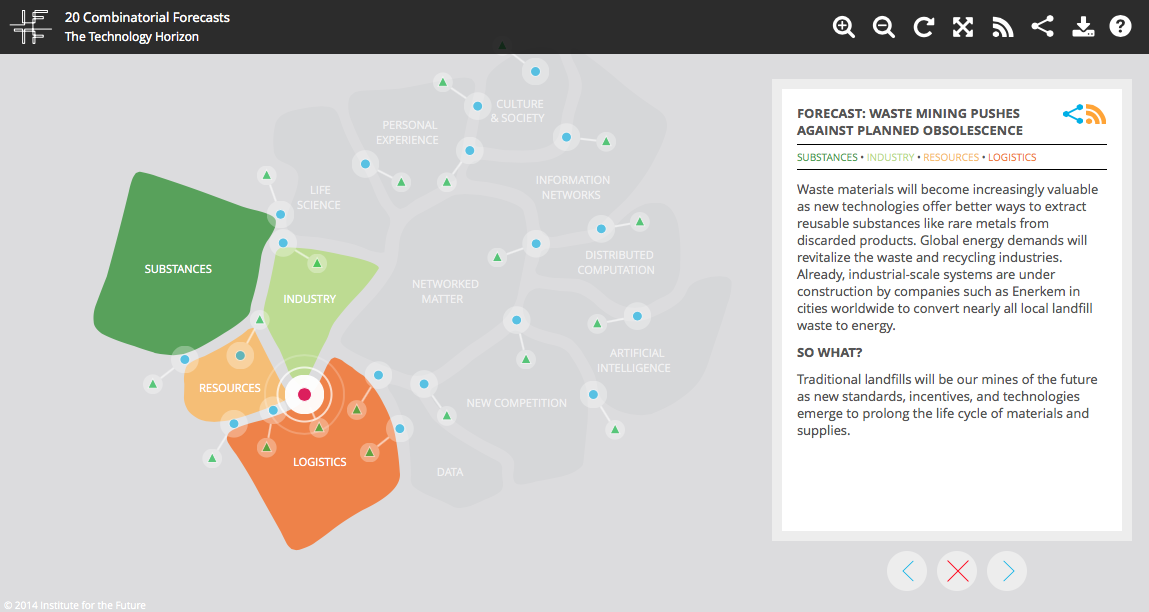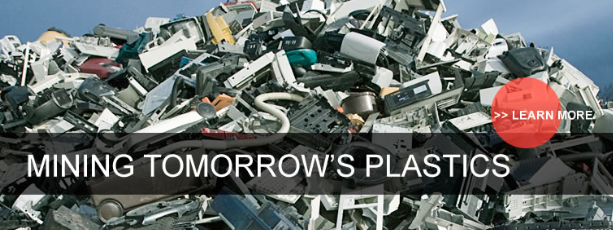Future Now
The IFTF Blog
From #20forecasts: Waste mining pushes against planned obsolescence
Did you know one metric ton of circuit boards contains 40-800 times as much gold as one metric ton of gold ore? Not to mention that up to 40% of landfill in the US is cardboard—an entirely recyclable material. As many countries around the world take a closer look at sustainability policies and climate change, one thing becomes immediately clear: landfills are an opportunity and a wake up call.
This coming decade will see that wake up call answered. Waste mining will push back against planned obsolescence as our ability to reuse and repurpose finally matches the waste generated by consumption.
At the intersection of logistics, resources, and industry, new recycling and manufacturing technologies are emerging that will enable every consumer product to be efficiently recycled. Landfills will be revisited and seen as massive untapped resources.
This is happening already ...
MBA Polymers, a California based company, can convert landfill plastics into ready-to-use plastics using 80% less energy than it takes to produce virgin plastics.
But digging through landfills to find recyclable materials is just a small part of the bigger story- a story about what ends up in landfills in the first place, and even how we think about landfills at all.
The full story:
Over the next decade as recycling technologies, consumer behavior, and resource scarcity intersect, we will see a shift from waste depositing to full-circle resource management. As full-circle resource management becomes a dominant model, landfills will be revisited and made use of. Three areas to pay closer attention to as this future unfolds are:
1) 0 waste cities
San Francisco aims to be a 0 waste city by 2020, meaning that 0 percent of the waste produced by households ends up in landfills—all will be either recycled or composted. Accomplishing this feat means applying pressures to manufacturers to shift to a reuse policy, relying on smarter consumer behavior, and city-wide ordinances, such as a ban on plastic bags. As cities aim to become 0 waste, they will invest in the recycling technologies necessary to cheaply reprocess consumer-grade plastics waste. These same technologies may be repurposed to revisit the landfill, and bring the plastics contained within back into circulation.
2) Redefining packaging
A company called Ecovative produces mycelium-based packaging materials. These materials, used mostly for protective packaging, provide a window to a future in which plastics and non-biodegradable materials make up far less of what goes into landfills outside of 0 waste cities.
3) Waste management through Biochemistry
In 2012, students from Yale on a trip to the Amazon discovered a fungi with an appetite for Polyurethane. For the first time in history, we’d found a form of life capable of digesting the previously un-biodegradable. Creating value out of landfills might leverage biological processes, or transform non-living matter into biofuels or compostable material.
In light of the whole story—efficiently recycling existing plastics, shifting values around consumption and new packaging types, and using biomanufacturing techniques for landfill processing—the coming decade will see a redefinition of 'waste,' and landfills may well be the new gold mines.
This post is the 7th in a series exploring IFTF's new interactive map from our Technology Horizons program, 20 Combinatorial Forecasts—featured in FastCompany Co.EXIST's "When Technologies Combine, Amazing Innovation Happens." Every few weeks we'll take a deep dive into another of the map's twenty forecasts on the future of technology at the intersections of different fields.
Curious about the Technology Horizons program?
- Follow the forecasts at @iftf and #20forecasts
- Find out more about the program
- Check out previous years' Technology Horizons research
- Contact Sean Ness (sness@iftf.org)





